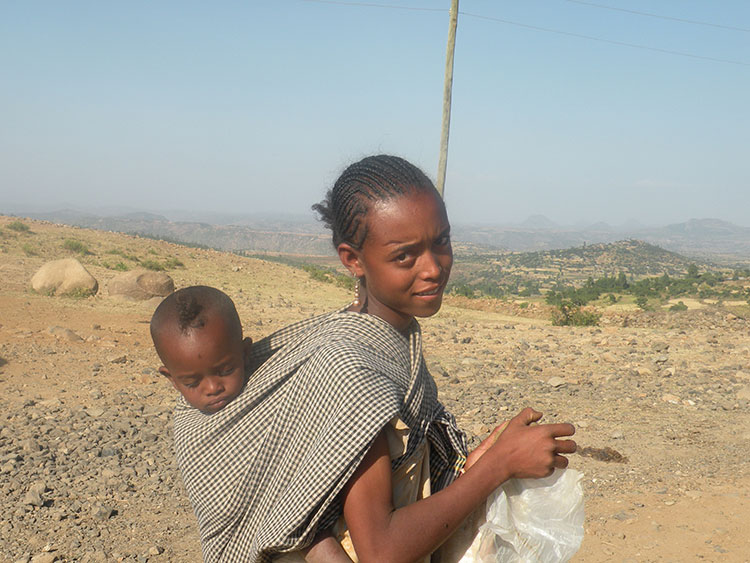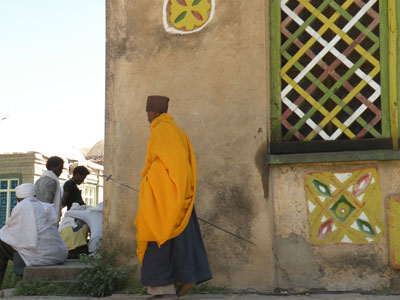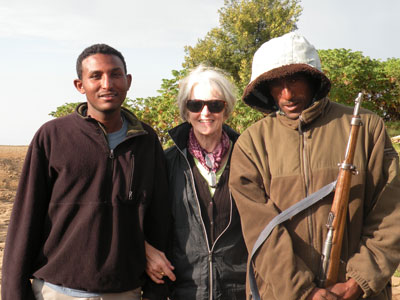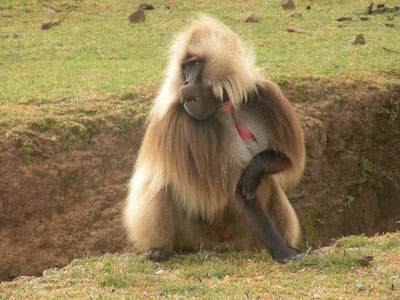Mountains, monkeys and monumental sites – a journey through Ethiopia continues
by Larry Kritcher, Coconut Grove, FL — This month, Rita and Larry Kritcher continue their account of their private tour of Ethiopia. We rejoin them as they leave the southern part of the country to explore the historic northern route.
Gondar, the capital of Ethiopia for 200 years (1635-1855), was the portal for a much different, less primitive part of our travels in October 2012. Contrary to our experience in the first half of our trip, as we moved north we ran into other people traveling the same circuit we had chosen.
Coptic sites
Our drive from the airport to the city center was on better roads, with less dust, and the high altitude had a coolness about it.
We were staying at the Taye Belay Hotel but noticed that other, newer establishments were under construction.
Here there was an entirely different set of travelers. This northern loop passed through the lands of the ancient Coptic Christians, better known today as Ethiopian Orthodox, who more or less dominated the northern part of the country. In these religious circles, the 17th-century Gondar churches are well known.
An unbelievably beat-up, rusty taxi took us to the church of Debre Berhan Selassie, a national treasure of Ethiopia and an ecclesiastical masterpiece. Pride rang from the guides’ voices as they pointed out the ceiling of 135 subtly smiling cherubs with huge eyes, typical of Ethiopian art, that stared down upon us. Wall paintings by 17th-century artists tell the stories of Christ, the Annunciation and St. George (their patron saint) slaying the dragon.
We began to understand that the world that Fasil, Raphael and our assorted guides lived in was dominated by religion. Not only do they live it, they are totally consumed by it.
There is a blurred edge in the war between older religious customs and the modern progressive world, with the latter losing the battle. Objects are counted in twelves (as in 12 apostles) and threes (as in the Trinity). The greatness of their past is praised while the present-day antiquated infrastructure and difficult living conditions of the masses are ignored.
Another site visited was Gondar’s Royal Enclosure. Mostly built by King Fasilides in the 1600s, it is slowly being restored with outside resources.
We visited King Fasilides’ Bath, a huge swimming pool surrounding a stone, castle-like bathhouse that is filled with water only for the Timkat religious festival in January.
Holy men in long, white, flowing robes were at prayer. On the tips of the staffs they held were ornate Ethiopian crosses made out of metal. Beautiful banyan trees graced the walled enclosure, giving refuge to a few trinket hawkers. Tourism is in its earliest stages here, apparent mostly in the selling of crosses and crucifixes.
The Simien Mountains
Fasil had a difficult time securing a vehicle for our next two days of driving toward Axum. Finally, after a few hours, it arrived. The 4x4 was a shabby 1986 Land Cruiser with cracked headlights, a goatskin on the dash, a crucifix hanging from the mirror and no air-conditioning. As we drove, we had to raise and lower the windows to avoid the dust from oncoming traffic. My window was so difficult to crank that I mostly left it open and swallowed the dust.
Eventually we arrived at Debark (Debarq) and our route into the Simien Mountains. A permit was secured, along with a local guide and an armed guard (governmental procedure) with a worn rifle. Now there were six people in our vehicle, with the guard sitting amid the luggage in the rear.
We inched our way up to the lodge that would be our home that night. The scenery was spectacular — albeit desolate and windswept.
The Simien Lodge, located at an altitude of 10,700 feet, boasts the highest bar in Africa.
The Simien Lodge was full, as it would be for months. I had heard that Ethiopian tour operators get preferential treatment when booking this premium lodge, though that may have been just a rumor spread by the guides. Other than camping, there is no other place to stay in the 70-square-mile park.
In the afternoon we drove through the dramatic escarpments and observed bleeding-heart baboons. Since they were unafraid of humans, we were able to approach them with ease. While the carefree young scampered and frolicked, the adults were busy foraging grass and making social contact.
High above us flew the lammergeier, vultures with 9-foot wingspans. Known to the locals as “bone crushers,” they are God’s landscape sanitation workers, feasting on leftovers. With larger bones, they pick them up in their talons and fly higher than high — out-of-sight high — then drop them, dashing them to pieces on the mountain’s rocky ledges before rushing to eat the marrow.
That night, the temperature dropped to the low 40s and we welcomed the hot-water bottles we were given to warm our beds after heading back to our cabin in the chilling wind.
A cliff-hanger
As we traveled back down to Debark, we would begin the most nerve-wracking portion of our northern journey. Now, I’ve related that our vehicle was 26 years old and not at all what we contracted for.* Thankfully, the driver, Mahmush, was extremely skilled because he had very little to work with.
The route north from Debark to Axum was on the most convoluted, twisting, cliff-hanging road we have ever been on anywhere on Earth. Just recalling it now causes my palms to sweat. Descending thousands of feet, it certainly could be considered a test of courage for all. I could not look out the windows. The drops were sheer and foooorrreeevvver.
There was a boulder every 10 feet or so — hardly enough to act as a guardrail but merely marking the edge of the road. Waterfalls ran across our path, rockslides had been plowed back, and the road was a single lane most of the time.
Oncoming traffic was rare, but each encounter required a negotiation as to who would back up or pull over to avoid tempting death by perhaps rolling his vehicle. Mahmush was trying to keep on schedule (why, I don’t know), so when he came to a straight stretch, he would gun the old jalopy and hit the next curve while braking heavily. A failed brake, a blown tire or one skid and we would have ended up in a violent tragedy.
We were hiding in the backseat, fingernails clawing at the window ledges. Springs squeaked as we bounced around every turn. Frankly, I was so scared that I didn’t hear Fasil telling us the story about how this road was constructed. I learned later it was a dose of African-Italian engineering that attempted to connect Gondar to Axum over 75 years ago, and it is still a work in progress.
So many workers died during the road’s construction that at the base, on a hairpin curve, there is a cemetery. I’m glad it was at the bottom! If this had been shown to me at the top, I would have walked down.
When we reached the bottom, Rita and I were exhausted and trembling from fear.
On to Axum
Once we recovered enough to notice, we saw, far down in the valley, that the trees were greener. The temperature was climbing as well and, as we had no air-conditioning, we rolled the windows down.
Then began the most laborious segment of this 7-hour travel day. As we entered the Tigray territory, halfway to Axum, we crossed a bridge that led us to what resembled hell on Earth, with the temperature now topping 39°C (102°F). We waited with a few other travelers as bulldozers dumped tons of dirt and boulders to form a new roadway, then leveled them into a somewhat drivable surface. Waiting times were as long as half an hour.
On the road again, our Land Cruiser twisted, bumped and winded around for hours as we clung to the handholds as if our lives depended upon it.
Choosing to skip the sandwiches provided by the Simien Lodge early in the morning, which had been rolling around the floor for a few hours, we stopped near the town of Inda Silase for a pizza at the African Hotel, a place we cannot recommend.
Finally, the next 50 kilometers into Axum were on a smooth, 2-lane, paved highway. ‘By Jove,’ I thought, ‘we are saved.’
We went directly to the Yeha Hotel, which was aged but comfortable. This would be our home for the next two days. Good-bye Mahmush, you dear soul; you must do the return drive back to Gondar all alone — absent our fearful screeching.
In Axum’s local archives, there is an amazing amount of 500-year-old scriptures written on goatskins. Illustrated in vivid color, they are startlingly well preserved and almost unknown. The world needs to see this country’s historic treasures.
Amazing churches
We began the last leg of our trip with an early-morning flight to Lalibela, with its rock-hewn churches, in north-central Ethiopia.
It seems that in the 12th century, King Lalibela was overtaken by religious fervor and decided to re-create Jerusalem so that all Ethiopians could enjoy this as their own holy land. The king had his workers cut into the rock, sawing into the solid stone to create these remarkable structures.
These churches were not built but, rather, were carved out of solid volcanic rock. Tons and tons of rock had to be removed, then artisans chiseled out the beams, columns, column capitals, stars and floral patterns.
These structures were amazing. How they did this is simply mind-boggling! It seemed to me that it would be like an ant removing grains of sand from Miami Beach. It is estimated that a massive workforce 40,000 strong took 23 years to complete 13 of these masterpieces. But their sheer artistry seems beyond human skill.
Monks live in and around these churches, murmuring their prayers, chanting songs and carrying staffs each tipped with a Lalibela Cross.
Shoes had to be removed before entering the churches, where fleas roamed about with special ecclesiastical privilege. Thankfully, we’d brought flea powder.
It was then back to Addis Ababa for our evening flight to Frankfurt. Before departing, we visited the National Museum and saw “Lucy” — at 3.2 million years old, the oldest remains of a human being at the time of her discovery. (Fossils have since been found in Ethiopia that are 4.4 million years old.)
We had had a most unusual journey to a little-visited land. We thoroughly enjoyed our guide, Fasil, who was extremely educated, knowledgeable, friendly and courteous, as were our skilled drivers, Raphael and Mahmush.
It should be noted that Rainbow Tours did warn us about the nasty road conditions between Gondar and Axum before we signed up for the trip.
The sights and scenery were spectacular and certainly historic.
*Rainbow Tours was gracious enough to refund us $400 for the vehicle mishap, so our day of torture turned into a cash refund. Notwithstanding, we both would rather have had more comfortable days with a newer ride. — LK




